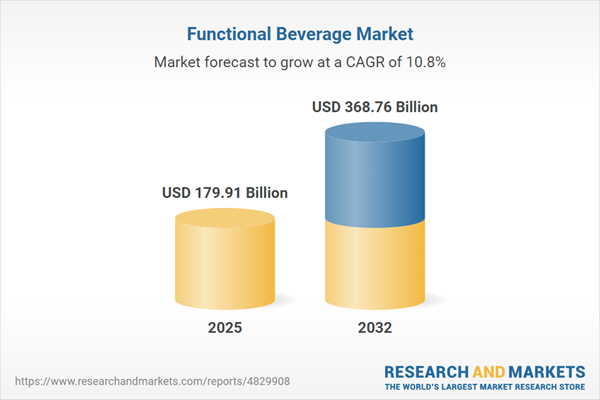Speak directly to the analyst to clarify any post sales queries you may have.
The functional beverage market is evolving rapidly as industry leaders focus on wellness, convenience, and data-driven product offerings. As consumer priorities shift, senior decision-makers face a complex landscape defined by changing tastes, regulatory demands, and innovation-led growth initiatives.
Market Snapshot: Global Functional Beverage Market
The global functional beverage market is valued at USD 162.33 billion in 2024, projected to reach USD 179.91 billion in 2025, and is anticipated to grow at a CAGR of 10.80% to achieve USD 368.76 billion by 2032. Consistent market expansion stems from greater health awareness, integration of validated ingredients, and a pronounced shift toward premiumization. As purchasing power rises in emerging and developed regions alike, industry portfolios now target a broader range of demographics and preferences. This strengthens innovation within supply chains and supports new business models to meet evolving consumer needs.
Scope & Segmentation of the Functional Beverage Market
- Product Types: Energy drinks (both carbonated and non-carbonated), functional waters (alkaline, detox, electrolyte, enhanced), nutritional drinks for meal replacements, medical nutrition, and weight management, a spectrum of plant-based beverage options, probiotic drinks using non-dairy bases, ready-to-drink tea and coffee, and specialized sports drinks including hypertonic, hypotonic, and isotonic varieties.
- Key Ingredients: Amino acids (such as branched-chain amino acids and L-glutamine), antioxidants (including green tea extract and resveratrol), caffeine from natural and synthetic sources, key electrolytes (magnesium, potassium, sodium), probiotics (Bifidobacterium, Lactobacillus strains), with comprehensive vitamin and mineral inclusion (calcium, magnesium, and B, C, D vitamins).
- Packaging Types: Bottles, cans, cartons, pouches, and sachets, each aligning with varying consumer preferences for convenience and sustainability.
- Distribution Channels: Bricks-and-mortar outlets, direct-to-consumer engagement, and digital platforms, offering flexible market access and adaptability to trends.
- End User Segments: Adults, athletes, children, and seniors, each with tailored solutions for wellness, performance, and specific functional requirements.
- Geographic Regions: Americas, Europe, Middle East & Africa, and Asia-Pacific, with deeper sub-regional and national analysis to support strategic choices for organizations targeting multinational or regional operations.
Key Takeaways for Senior Decision-Makers
- Personalized nutrition is central, leveraging digital platforms to improve customer engagement and loyalty across diverse product categories and consumer types.
- Formulation advances led by adaptogens, nootropics, and innovative plant-based compounds are reframing consumer expectations and driving better value recognition.
- Growing demand for sustainability and transparency prompts businesses to adopt clear ingredient sourcing, promote circular and biodegradable packaging, and demonstrate environmental responsibility across supply chains.
- Partnerships with biotech and research organizations accelerate new ingredient launches and facilitate agile responses to global health trends and shifting consumer demands.
- Advanced analytics and predictive tools enhance product development, enabling closer alignment with rapidly changing consumer behavior and demand signals in key markets.
- Digital forecasting and preemptive product reformulation support cost management and compliance, equipping companies to adapt to shifting regulatory expectations efficiently.
Tariff Impact on Cross-Border Trade
New tariffs in the United States from 2025 present cross-border sourcing challenges for ingredient buyers and manufacturers. To address this, many businesses increase nearshoring, prioritize local sourcing partnerships, and tailor product formulations to match regional availability. This approach brings added flexibility and ensures organizations remain compliant with regulatory frameworks, especially in volatile supply environments. Localized manufacturing and robust supply chain collaboration have become critical in sustaining both competitiveness and operational resilience under shifting trade conditions.
Methodology & Data Sources
This report incorporates direct interviews with executives from ingredient suppliers, manufacturers, and brands, and draws on perspectives from regulatory experts. Comprehensive quantitative analysis, peer-reviewed academic sources, relevant industry trade publications, and real-time sentiment data together ensure reliable, actionable intelligence for strategy development.
Why This Report Matters
- Offers actionable insight into emerging product development, digital technology, and distribution opportunities, segmented by region and end user to guide focused planning.
- Enables senior leaders to anticipate regulatory changes, exceed consumer expectations, and benchmark corporate approaches against primary competitors in the functional beverage market.
- Equips decision-makers with robust, data-based recommendations for entering new markets, optimizing supply chains, and building competitive advantage in a rapidly evolving sector.
Conclusion
Innovation, regulatory change, and rising consumer standards will continue to shape the functional beverage sector. Organizations investing in technology, responsible practices, and flexible strategies are best placed for sustainable, long-term success.
Additional Product Information:
- Purchase of this report includes 1 year online access with quarterly updates.
- This report can be updated on request. Please contact our Customer Experience team using the Ask a Question widget on our website.
Table of Contents
3. Executive Summary
4. Market Overview
7. Cumulative Impact of Artificial Intelligence 2025
List of Figures
Companies Mentioned
The key companies profiled in this Functional Beverage market report include:- The Coca-Cola Company
- PepsiCo, Inc.
- Nestlé S.A.
- Red Bull GmbH
- Monster Beverage Corporation
- Danone S.A.
- Keurig Dr Pepper Inc.
- Suntory Beverage & Food Limited
- Asahi Group Holdings, Ltd.
- Yakult Honsha Co., Ltd.
Table Information
| Report Attribute | Details |
|---|---|
| No. of Pages | 180 |
| Published | October 2025 |
| Forecast Period | 2025 - 2032 |
| Estimated Market Value ( USD | $ 179.91 Billion |
| Forecasted Market Value ( USD | $ 368.76 Billion |
| Compound Annual Growth Rate | 10.8% |
| Regions Covered | Global |
| No. of Companies Mentioned | 11 |









